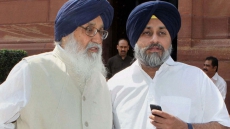I have always found it tedious to answer the question: "Which is your hometown?" Not because I am a daughter of an army officer or belong to a family of travellers, but because "I was born in Srinagar and was brought up in Jammu." I have been using this statement since the early 1990s to introduce myself, deliberately avoiding the word "Kashmiri Migrant".
The feeling of being a migrant or displaced in your own country brings in a sense of irreparable loss as it evokes blurred memories of childhood and reinforces the turmoil the community of Kashmiri Pandits faced when mass exodus took place in early 1990s uprooting over 100,000 Hindu Pandits from their homes due to an Islamist insurgency that still festers.
So the answer to that very basic "hometown" question invites mixed reactions, majorly sympathy.
Sympathy is the last thing Kashmiri Pandits want, but unfortunately this is what has always been the offering. It is, I feel, because many fail to understand the sense of homelessness that has stayed with us ever since, and refuses to fade away even today. And it is this permanent restlessness that a bleak thought of going back to our "home" brightens up our soul, even though temporarily.
But this soul was shattered the day it was known that the government plans to build "composite clusters" to rehabilitate displaced Pandits so that we could relive those lost years and stop lamenting about homecoming. We have always longed for home, but this home, ironically, doesn't belong to the world we reside in now.
This world doesn't break into curfews, offers employment opportunities, doesn't deprive me of cinema halls and it is where I can fearlessly and proudly wear my Indianness on my sleeve. And this is the place where the displaced Pandits have restarted their life and rebuilt the foundations of their cultural composition.
It is their home now and 25 years is a long time for memories to fade away silently. These two decades have also alienated the young Kashmiri generation from the struggle because they understand the importance of the word "Kashmir" only when they apply for "Kashmiri quota" for higher education. It is only then this tag comes really handy.
Please don't judge me for the rude statement, but when I look around I feel those who started their life in exile at a young age, adjusted to the newly-found environs, and those who were born outside the Valley never really had the umbilical chord attached to their roots.

Whereas the older generation still romances nostalgia and laments about the life and times they had in Kashmir during their growing up years, especially its picturesque marvels, chilling winters and difficult treks, the younger generation is introduced to these elements via personal anecdotes and stories.
It would be apt to say that many of us have moved on, settled down and alienated ourselves from the idea of Kashmir.
A subtle proof of this statement is that we are building a generation that can't speak the Kashmiri language. In many houses, parents speak to their children in Hindi so that they are not laughed at for the "funny accent" - something this displaced community was initially made fun of. It has become a language we understand, but barely speak any more. We have compromised and adjusted to the rules of the new world.
Uprooting an entire community from their homes not only displaces its people, it silently withers away the intangible culture and shared history. Culture, indeed, has become the biggest causality of our never-ending exile.
So when we have left so much behind, what is there to look forward to?
Why does the soul feel wretched at the thought of these "clusters" that invite mirth and disbelief at the same time? This proposal has already generated another controversy related to rehabilitation of Pandits and questioned the vision of the government that aims to bring us home with "dignity".
Homecoming has been a distant dream. It might be the right time to think in this direction, but let's honestly ask ourselves one question - How many of us are actually willing to return to the Valley? Are we mentally prepared to push the restart button again?
There would be a handful who would want to go back for a better life, with the hope to shun the life of penury. There are those who still haven't sold their homes and those who pine to go back home for mental peace.
But, it isn't just the question of building houses and rehabilitating.
Does the government have employment plans to ensure they are not merely "fulfilling poll promises" but are addressing real issues that relate to rehabilitation holistically?
As a Pandit friend, who is currently teaching in a school in Srinagar after the central government had launched a scheme a few years ago under which it provided employment to the younger generation in schools and government departments, informs me how living in Kashmir is like living in an Islamic state and if anyone wants to come here, he/she should only come as a tourist and not for settling down.

It is a strong statement to make and highlights how the choice offered should come with sustainable options and not merely as tokenism to woo voters for the next elections.
The journey to home is arduous and long. But it is a choice we have to make. As the heart proposes, the mind opposes... leaving little room for conversation that could lead to meaningful discussion.





